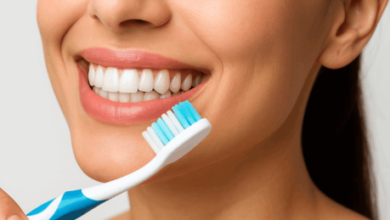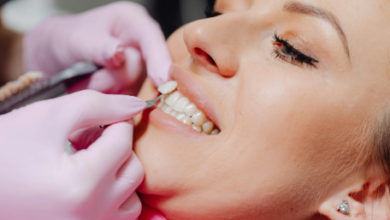Achieve Your Dream Smile with Dental Bonding in Toronto

Understanding Dental Bonding in Toronto
What is Cosmetic Bonding?
Cosmetic bonding, often called dental bonding, is a popular way to fix minor imperfections in your smile. It uses a tooth-colored resin material to improve the appearance of your teeth. Think of it like a sculptor using clay to reshape something, but instead of clay, it’s a special resin, and instead of a sculpture, it’s your tooth! It’s a pretty straightforward process, and it can make a big difference in how you feel about your smile.
The Dental Bonding Procedure Explained
So, how does dental bonding actually work? Well, it’s a pretty simple process. First, the dentist will lightly prepare the surface of your tooth. This helps the bonding material stick better. Then, they apply the resin, carefully shaping and molding it to the desired look. A special light is used to harden the resin, and finally, the dentist polishes it to match the rest of your teeth. The whole thing can often be done in a single visit, which is a big plus for busy people.
Benefits of Dental Bonding
Why choose dental bonding in Toronto? Here are a few good reasons:
- It’s relatively inexpensive compared to other cosmetic options.
- It’s a non-invasive procedure, meaning minimal tooth enamel is removed.
- It can be completed quickly, often in just one visit.
- It can fix a variety of issues, from chips and cracks to discoloration and gaps.
Dental bonding is a great option for people looking for a quick and affordable way to improve their smile. It’s not as permanent as some other treatments, but it’s a good starting point for many cosmetic dental concerns. Plus, it’s a reversible procedure, so you’re not locked into anything forever.
Ideal Candidates for Dental Bonding
Dental bonding is a fantastic option for many people looking to improve their smile, but it’s not a one-size-fits-all solution. It works best for correcting minor imperfections. If you’re dealing with more significant dental issues, other cosmetic procedures might be more suitable. Let’s take a closer look at who makes an ideal candidate for dental bonding.
Addressing Chipped or Cracked Teeth
One of the most common reasons people consider dental bonding is to fix chipped or cracked teeth. Dental bonding can effectively restore the natural shape and appearance of a tooth that has suffered minor damage. It’s a relatively quick and easy way to get your smile back on track. However, if the chip or crack is extensive, a crown or veneer might be a better, more durable solution. If you have a dental emergency in Toronto, bonding can be a quick fix until a more permanent solution can be implemented.
Closing Gaps Between Teeth
Small gaps between teeth can be easily closed with dental bonding. The composite resin is applied to the adjacent teeth, effectively filling the space and creating a more uniform smile. This is a less invasive and more affordable alternative to orthodontics for minor spacing issues. It’s important to note that bonding is best suited for small gaps; larger gaps might require more extensive treatment.
Correcting Discoloration and Stains
Dental bonding can also be used to cover up stubborn stains or discoloration that don’t respond to traditional teeth whitening methods. The composite resin is matched to the natural color of your teeth, providing a brighter, more even smile. While bonding can mask discoloration, it’s important to address the underlying cause of the staining to prevent future issues. Keep in mind that the bonding material itself can stain over time, so proper oral hygiene is essential.
Dental bonding is a great option for those seeking a quick and affordable way to address minor cosmetic dental issues. It’s less invasive than other procedures and can provide immediate results. However, it’s important to have realistic expectations and understand that bonding may not be the best solution for everyone.
Here’s a quick comparison of issues and suitability:
| Issue | Bonding Suitability | Alternative Solutions |
| Small Chips/Cracks | High | Veneers, Crowns |
| Minor Gaps | High | Orthodontics |
| Stubborn Stains | Medium | Veneers, Professional Whitening |
| Large Cracks/Breaks | Low | Crowns, Implants |
| Significant Misalignment | Low | Orthodontics |
The Dental Bonding Process in Toronto
Initial Consultation and Assessment
So, you’re thinking about dental bonding? The first step is always chatting with your dentist in Toronto. They’ll take a good look at your teeth to see if bonding is the right move for you. This isn’t just a quick glance; they’re checking things like the overall health of your teeth, the extent of any damage, and what you’re hoping to achieve with the procedure. They might even take X-rays to get a better view. It’s a good time to ask all your questions and make sure you’re comfortable with the plan.
Application and Shaping of Resin
Okay, so you’ve decided to go ahead with the bonding. Now comes the fun part! The dentist will start by prepping the surface of your tooth. This usually involves lightly etching it to create a rough surface, which helps the resin stick better. Then, they’ll apply the composite resin, which is basically a putty-like material that matches the color of your teeth. The dentist will carefully mold and shape the resin to achieve the desired look. It’s like sculpting a tiny masterpiece right on your tooth!
Curing and Polishing for a Natural Finish
Once the resin is shaped just right, it’s time to harden it. The dentist will use a special UV light to “cure” the resin, making it hard and durable. This process only takes a few minutes. After the resin is hardened, the dentist will polish it to a smooth, natural-looking finish. They’ll also make any final adjustments to ensure it blends seamlessly with your other teeth. When it’s all done, you’ll have a beautifully restored smile!
The whole process is usually pretty quick and painless. Most people don’t even need anesthesia. It’s a relatively simple way to fix minor imperfections and boost your confidence in your smile. Plus, it’s less invasive than some other cosmetic dental procedures, which is always a bonus.
Comparing Dental Bonding to Other Cosmetic Options
So, you’re thinking about fixing up your smile, and dental bonding is on your radar. That’s great! But it’s smart to see how it stacks up against other options. Let’s break it down.
Bonding Versus Dental Veneers
Okay, bonding and veneers both make your teeth look better, but they’re pretty different. Veneers are like a complete makeover, while bonding is more like a quick touch-up. Veneers are thin shells that go over the entire front surface of your tooth. They’re good for bigger changes, like fixing serious discoloration, chips, or even the shape of your teeth. Bonding, on the other hand, uses a resin that’s applied directly to the tooth. It’s better for smaller stuff, like little chips or gaps. Veneers last longer, but they also cost more. Bonding is cheaper, but you might need to get it redone after a few years.
Bonding Versus Orthodontic Treatments
Think of bonding as a shortcut and orthodontics (like braces or Invisalign) as the long, scenic route. If your teeth are seriously crooked or misaligned, orthodontics is the way to go. It actually moves your teeth into the right position. Bonding can sometimes make teeth look straighter by adding resin to certain spots, but it’s just an illusion. It won’t fix the underlying problem. Orthodontics takes time and money, but it gives you a real, lasting fix. Bonding is faster and cheaper, but it’s only for minor cosmetic issues.
Cost-Effectiveness of Dental Bonding
Let’s talk money. Bonding is usually the cheapest cosmetic option upfront. Veneers cost more per tooth, and orthodontics can cost thousands. But here’s the thing: bonding doesn’t last forever. You’ll probably need to get it touched up or redone every few years. So, while the initial cost is low, the long-term cost can add up. Veneers and orthodontics are more of an investment, but they also last longer and can give you better results. It really depends on your budget and what you’re trying to fix.
Choosing the right treatment really depends on what you want to achieve and how much you’re willing to spend. Bonding is great for small fixes and tight budgets, but it’s not a miracle cure. Talk to your dentist about all your options to see what makes the most sense for you.
Longevity and Care for Your Bonded Teeth
Expected Lifespan of Dental Bonding
So, you’ve got dental bonding! That’s awesome. Now you’re probably wondering how long this fix is going to last. Well, dental bonding isn’t forever, but it can stick around for a good while with the right care. Generally, you can expect dental bonding to last anywhere from 3 to 10 years. It really depends on a few things, like where the bonding is in your mouth, your eating habits, and how well you take care of your teeth. Think of it like this: front teeth bonding might need a touch-up sooner than bonding on teeth that don’t do as much chewing.
Maintaining Your Bonded Smile
Taking care of your bonded teeth isn’t rocket science, but it does require some attention. Here’s the lowdown:
- Brush and floss regularly: Just like with your natural teeth, good oral hygiene is key. Brush at least twice a day and floss once a day to keep plaque and bacteria at bay.
- Avoid hard or sticky foods: These can chip or damage the bonding material. Think twice before biting into hard candies or chewing on ice.
- Watch out for staining: Bonding material can stain over time, especially from things like coffee, tea, and red wine. Try to limit these, or rinse your mouth after having them.
- See your dentist regularly: Regular check-ups are important so your dentist can keep an eye on your bonding and catch any problems early.
It’s important to remember that dental bonding is not as strong as your natural tooth enamel. Treat it with care, and it will last longer. Avoid using your bonded teeth to open packages or chew on pens – you’d be surprised how many people do that!
When to Consider Touch-Ups or Replacement
Even with the best care, dental bonding will eventually need a touch-up or replacement. Here are some signs it might be time:
- Chipping or cracking: If you notice any chips or cracks in the bonding material, it’s time to see your dentist.
- Staining or discoloration: If the bonding material becomes noticeably stained or discolored, a touch-up can help restore its appearance.
- Rough edges: If the bonding material feels rough or uneven, it might need to be smoothed out.
- Receding gums: If your gums recede around the bonding, it can expose the edge of the material and make it more vulnerable to damage.
Basically, if anything feels off or looks different, it’s always a good idea to get it checked out. A quick visit to your dentist can keep your smile looking its best!
Cost of Dental Bonding in Toronto
Factors Influencing Bonding Costs
So, you’re thinking about dental bonding? Great! One of the first things people wonder is, “How much will this set me back?” Well, the cost of dental bonding in Toronto can vary quite a bit. It’s not a one-size-fits-all situation. Several things play a role in determining the final price.
- Number of Teeth: Obviously, bonding more teeth means a higher overall cost. Each tooth requires time and material.
- Complexity of the Work: A small chip is way easier (and cheaper) to fix than a large crack or gap.
- Location of the Tooth: Front teeth are usually more straightforward, while back teeth might be trickier to reach, potentially increasing the cost.
- Dentist’s Experience: More experienced cosmetic dentists might charge more, but you’re also paying for their skill and artistry. Think of it as an investment in a natural-looking smile.
Insurance Coverage for Dental Bonding
Now, let’s talk about insurance. Will your insurance company help cover the cost of dental bonding? It depends. Generally, insurance is more likely to cover bonding if it’s needed to repair a damaged tooth (like from an accident) rather than purely for cosmetic reasons. It’s always a good idea to check with your insurance provider to see what their policy is. They can give you the specifics of your coverage. If it’s deemed medically necessary, you might get a significant portion covered. If it’s purely cosmetic, you might be on your own. But hey, it’s always worth asking!
Affordable Smile Enhancements
Dental bonding is often seen as a more budget-friendly option compared to other cosmetic procedures like veneers or even dental implants in Toronto. It’s a way to make a noticeable improvement to your smile without breaking the bank. While the exact cost depends on the factors mentioned earlier, it’s generally more accessible for people looking for smile enhancements. Plus, it’s a relatively quick procedure, often done in a single visit, which can save you time and money in the long run. Just remember to factor in the potential need for touch-ups down the road, as bonding isn’t permanent.
It’s important to remember that the cheapest option isn’t always the best. Consider the dentist’s experience, the quality of materials they use, and their commitment to creating a natural-looking result. A slightly higher initial investment might save you money and headaches in the long run by avoiding the need for frequent repairs or replacements.
Choosing a Dental Bonding Provider in Toronto
Finding the right dentist for dental bonding is important. You want someone who knows what they’re doing and makes you feel comfortable. It’s not just about fixing a tooth; it’s about improving your smile and confidence.
Expertise in Cosmetic Dentistry
When looking for a dentist, check their background in cosmetic dentistry. Look for someone with experience specifically in dental bonding. It’s a good idea to ask about how many bonding procedures they’ve done and if they have before-and-after photos you can look at. Also, see if they keep up with the latest techniques and materials. Cosmetic dentistry is always changing, and you want someone who’s up-to-date. Some dentists also offer other cosmetic options like veneers in Toronto, so it’s good to know if they have a wide range of solutions.
Patient-Centered Approach
A good dentist should focus on you as a person, not just your teeth. They should listen to your concerns, explain the procedure clearly, and answer all your questions. You should feel comfortable discussing your goals and expectations. The dentist should also take the time to understand your overall oral health and how dental bonding fits into your long-term dental care plan. It’s a partnership, and you want someone who values your input.
Booking Your Dental Bonding Consultation
Setting up a consultation is the first step. During the consultation, the dentist will examine your teeth, discuss your options, and give you a realistic idea of what to expect. Here are a few things to consider when booking:
- Check if they offer free consultations.
- Ask about payment options and financing plans.
- Read online reviews to see what other patients say.
Choosing a dentist is a big decision. Take your time, do your research, and find someone you trust. A great smile can make a big difference in your life, so it’s worth the effort to find the right provider.
Ready for a Brighter Smile?
So, there you have it. Dental bonding is a pretty straightforward way to fix up those little things about your smile that might bother you. It’s quick, usually doesn’t hurt, and it won’t break the bank compared to some other options. If you’ve got a chip, a gap, or just want to make your teeth look a bit better, it’s definitely worth checking out. Why not give a Toronto dentist a call and see if dental bonding is the right fit for you? You might be surprised how easy it is to get that smile you’ve always wanted.




